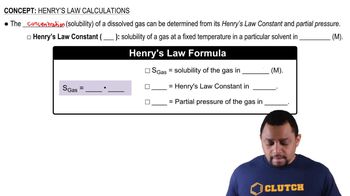Here are the essential concepts you must grasp in order to answer the question correctly.
Polarity and Solubility
Polarity refers to the distribution of electrical charge over the atoms in a molecule. Polar molecules, which have a significant difference in electronegativity between their atoms, tend to dissolve well in polar solvents like water due to favorable interactions. In contrast, nonpolar molecules do not interact favorably with water, leading to lower solubility. Understanding the polarity of hydrocarbons like methane, ethane, and ethylene is crucial for explaining their solubility in water.
Recommended video:
Intermolecular Forces
Intermolecular forces are the forces of attraction or repulsion between molecules. These include hydrogen bonding, dipole-dipole interactions, and London dispersion forces. The strength and type of these forces significantly influence the solubility of gases in water. For example, hydrogen sulfide (H2S) can form hydrogen bonds with water, enhancing its solubility compared to nonpolar gases like nitrogen (N2).
Recommended video:
Intermolecular vs Intramolecular Forces
Henry's Law
Henry's Law states that the amount of gas that dissolves in a liquid at a given temperature is directly proportional to the partial pressure of that gas above the liquid. This principle helps explain the solubility of gases in water under varying conditions. For instance, the solubility of gases like nitric oxide (NO) can be understood in terms of its interactions with water and the pressure exerted by the gas, which influences how much of it can dissolve.
Recommended video:





